GEN 301 Professional Ethics Assignment: Summer II 2017 Analysis
VerifiedAdded on 2020/02/24
|7
|1316
|1314
Homework Assignment
AI Summary
This assignment, completed for the GEN 301 Professional Ethics course during the Summer II 2017 semester, addresses several key concepts in ethical decision-making. The first question examines how diffusion of responsibility and conformity within organizations can lead to unethical behavior. The second question compares consequentialist and non-consequentialist ethical theories, outlining the advantages and disadvantages of each approach. Finally, the assignment explores John Rawls' veil of ignorance, discussing its potential to ensure justice for all. The student's answers are supported by relevant academic references, providing a comprehensive analysis of the topics discussed.
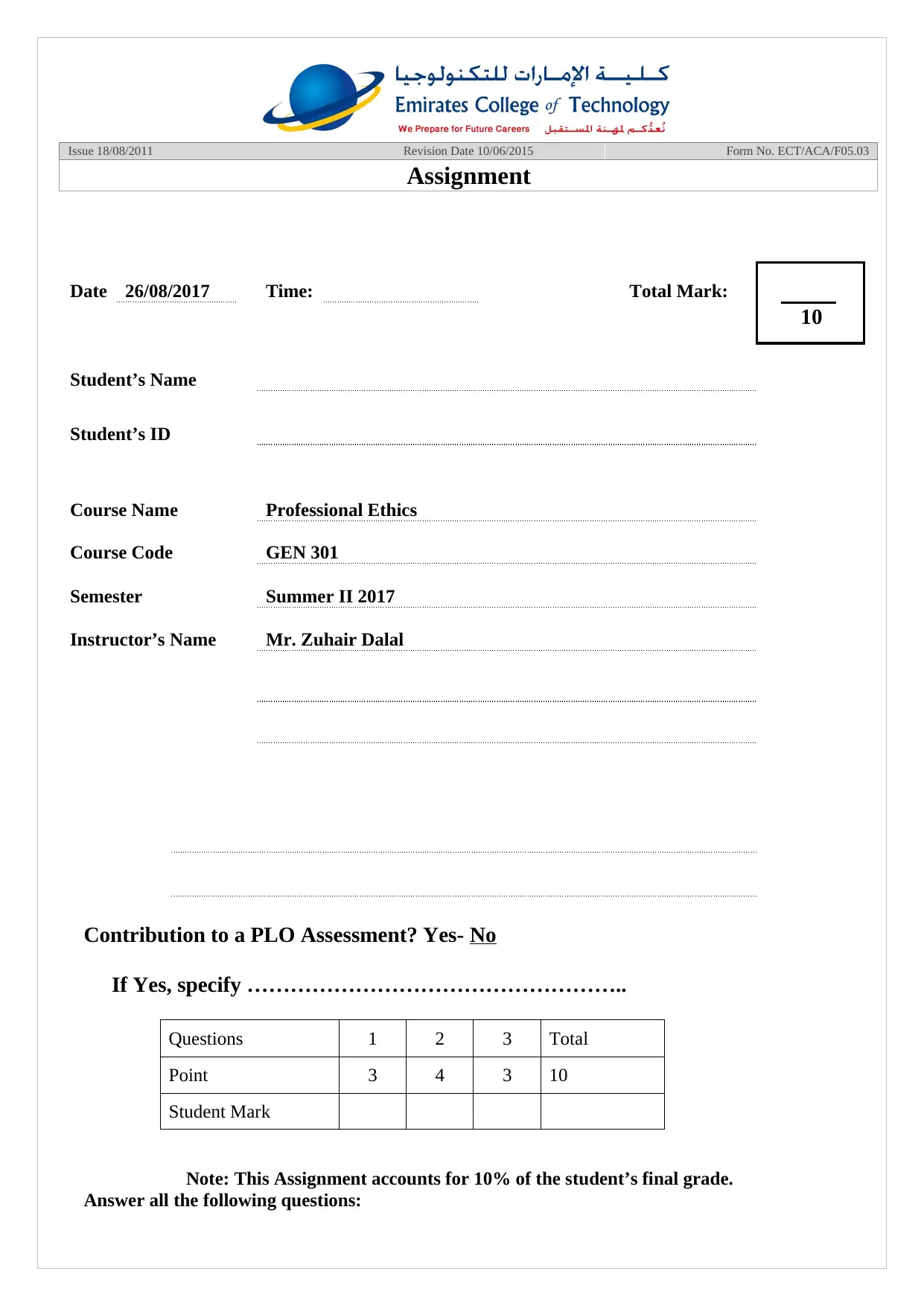
Issue 18/08/2011 Revision Date 10/06/2015 Form No. ECT/ACA/F05.03
Assignment
Date 26/08/2017 Time: Total Mark:
10
Student’s Name
Student’s ID
Course Name Professional Ethics
Course Code GEN 301
Semester Summer II 2017
Instructor’s Name Mr. Zuhair Dalal
Contribution to a PLO Assessment? Yes- No
If Yes, specify ……………………………………………..
Note: This Assignment accounts for 10% of the student’s final grade.
Answer all the following questions:
Questions 1 2 3 Total
Point 3 4 3 10
Student Mark
Assignment
Date 26/08/2017 Time: Total Mark:
10
Student’s Name
Student’s ID
Course Name Professional Ethics
Course Code GEN 301
Semester Summer II 2017
Instructor’s Name Mr. Zuhair Dalal
Contribution to a PLO Assessment? Yes- No
If Yes, specify ……………………………………………..
Note: This Assignment accounts for 10% of the student’s final grade.
Answer all the following questions:
Questions 1 2 3 Total
Point 3 4 3 10
Student Mark
Paraphrase This Document
Need a fresh take? Get an instant paraphrase of this document with our AI Paraphraser
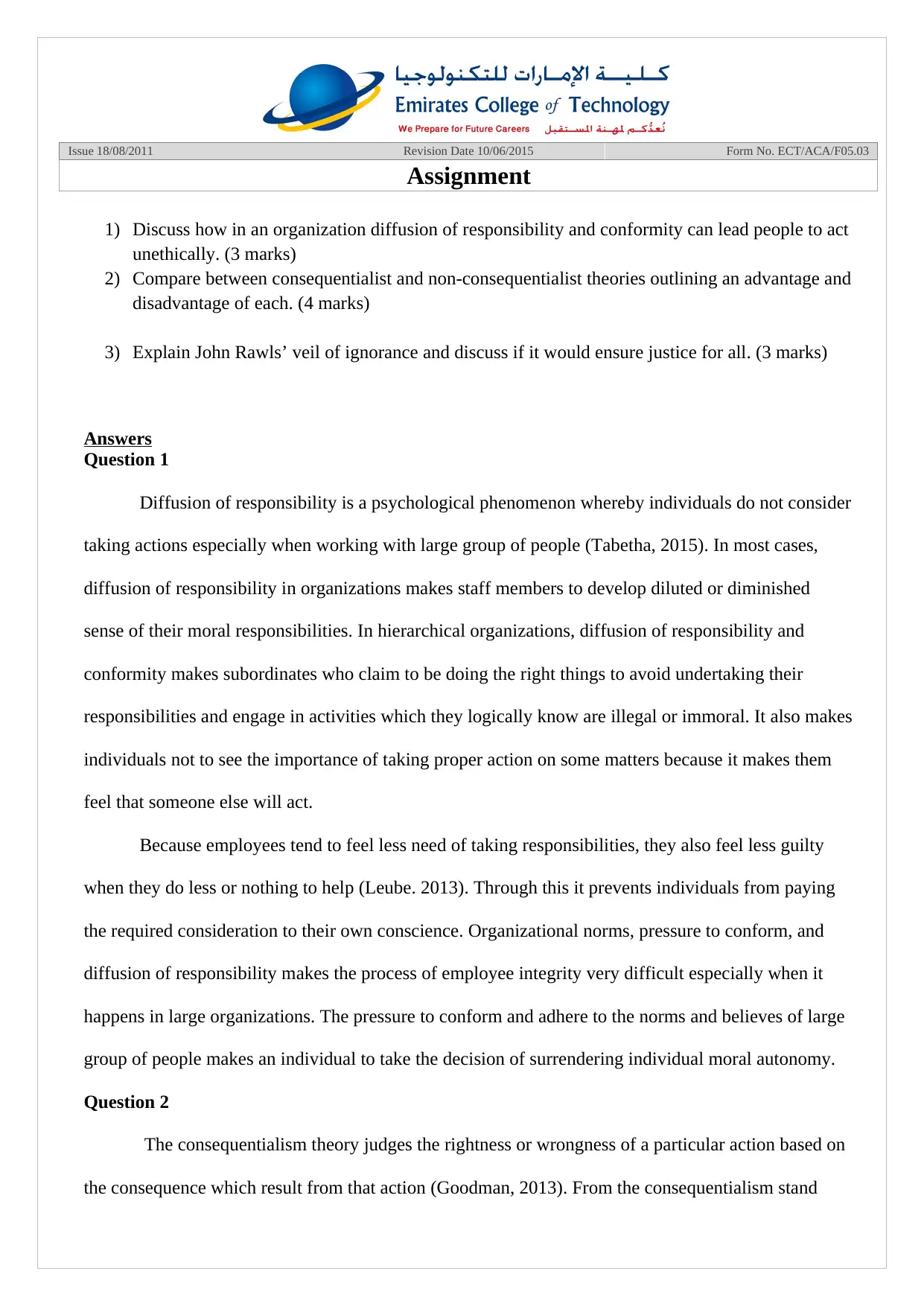
Issue 18/08/2011 Revision Date 10/06/2015 Form No. ECT/ACA/F05.03
Assignment
1) Discuss how in an organization diffusion of responsibility and conformity can lead people to act
unethically. (3 marks)
2) Compare between consequentialist and non-consequentialist theories outlining an advantage and
disadvantage of each. (4 marks)
3) Explain John Rawls’ veil of ignorance and discuss if it would ensure justice for all. (3 marks)
Answers
Question 1
Diffusion of responsibility is a psychological phenomenon whereby individuals do not consider
taking actions especially when working with large group of people (Tabetha, 2015). In most cases,
diffusion of responsibility in organizations makes staff members to develop diluted or diminished
sense of their moral responsibilities. In hierarchical organizations, diffusion of responsibility and
conformity makes subordinates who claim to be doing the right things to avoid undertaking their
responsibilities and engage in activities which they logically know are illegal or immoral. It also makes
individuals not to see the importance of taking proper action on some matters because it makes them
feel that someone else will act.
Because employees tend to feel less need of taking responsibilities, they also feel less guilty
when they do less or nothing to help (Leube. 2013). Through this it prevents individuals from paying
the required consideration to their own conscience. Organizational norms, pressure to conform, and
diffusion of responsibility makes the process of employee integrity very difficult especially when it
happens in large organizations. The pressure to conform and adhere to the norms and believes of large
group of people makes an individual to take the decision of surrendering individual moral autonomy.
Question 2
The consequentialism theory judges the rightness or wrongness of a particular action based on
the consequence which result from that action (Goodman, 2013). From the consequentialism stand
Assignment
1) Discuss how in an organization diffusion of responsibility and conformity can lead people to act
unethically. (3 marks)
2) Compare between consequentialist and non-consequentialist theories outlining an advantage and
disadvantage of each. (4 marks)
3) Explain John Rawls’ veil of ignorance and discuss if it would ensure justice for all. (3 marks)
Answers
Question 1
Diffusion of responsibility is a psychological phenomenon whereby individuals do not consider
taking actions especially when working with large group of people (Tabetha, 2015). In most cases,
diffusion of responsibility in organizations makes staff members to develop diluted or diminished
sense of their moral responsibilities. In hierarchical organizations, diffusion of responsibility and
conformity makes subordinates who claim to be doing the right things to avoid undertaking their
responsibilities and engage in activities which they logically know are illegal or immoral. It also makes
individuals not to see the importance of taking proper action on some matters because it makes them
feel that someone else will act.
Because employees tend to feel less need of taking responsibilities, they also feel less guilty
when they do less or nothing to help (Leube. 2013). Through this it prevents individuals from paying
the required consideration to their own conscience. Organizational norms, pressure to conform, and
diffusion of responsibility makes the process of employee integrity very difficult especially when it
happens in large organizations. The pressure to conform and adhere to the norms and believes of large
group of people makes an individual to take the decision of surrendering individual moral autonomy.
Question 2
The consequentialism theory judges the rightness or wrongness of a particular action based on
the consequence which result from that action (Goodman, 2013). From the consequentialism stand
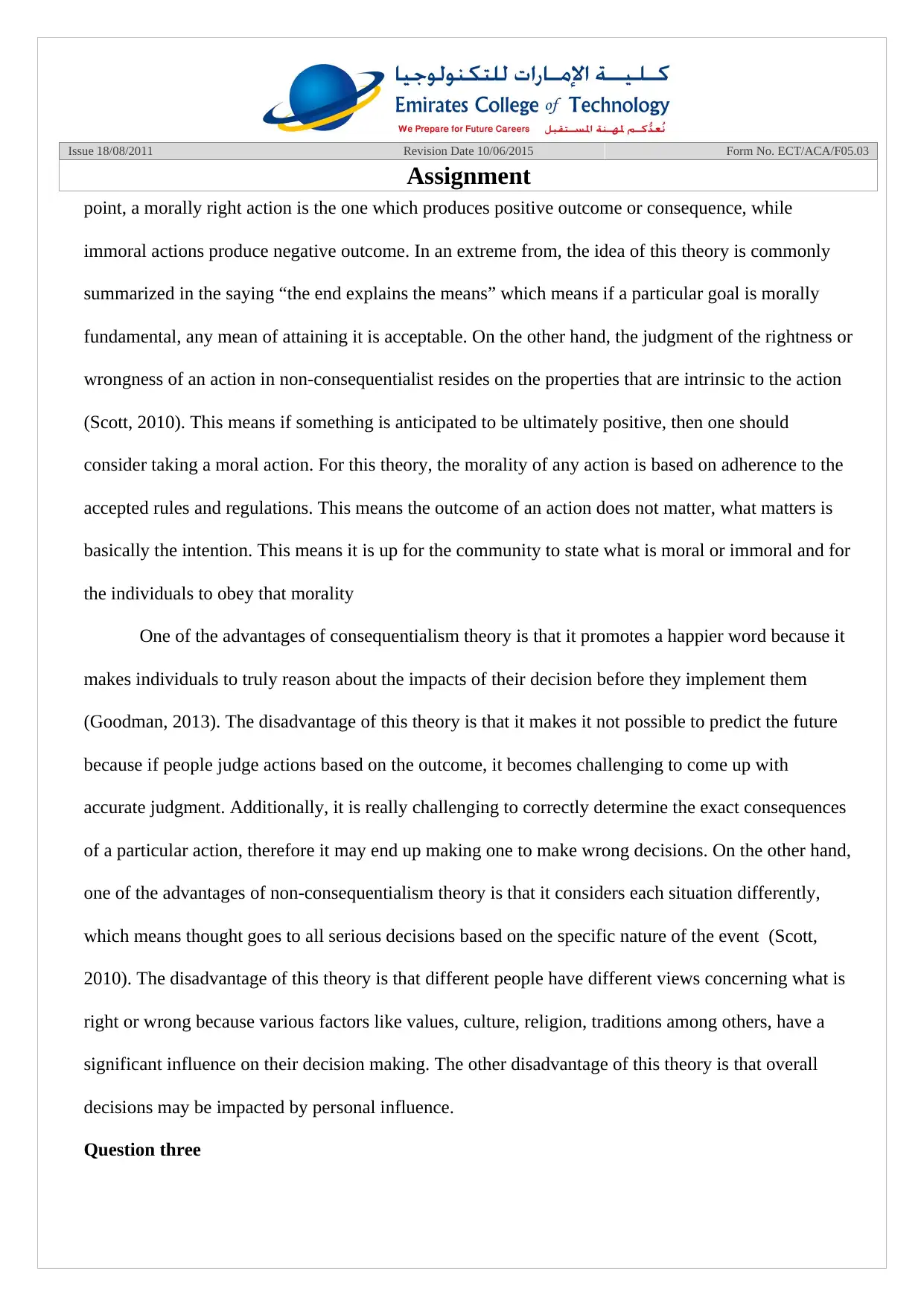
Issue 18/08/2011 Revision Date 10/06/2015 Form No. ECT/ACA/F05.03
Assignment
point, a morally right action is the one which produces positive outcome or consequence, while
immoral actions produce negative outcome. In an extreme from, the idea of this theory is commonly
summarized in the saying “the end explains the means” which means if a particular goal is morally
fundamental, any mean of attaining it is acceptable. On the other hand, the judgment of the rightness or
wrongness of an action in non-consequentialist resides on the properties that are intrinsic to the action
(Scott, 2010). This means if something is anticipated to be ultimately positive, then one should
consider taking a moral action. For this theory, the morality of any action is based on adherence to the
accepted rules and regulations. This means the outcome of an action does not matter, what matters is
basically the intention. This means it is up for the community to state what is moral or immoral and for
the individuals to obey that morality
One of the advantages of consequentialism theory is that it promotes a happier word because it
makes individuals to truly reason about the impacts of their decision before they implement them
(Goodman, 2013). The disadvantage of this theory is that it makes it not possible to predict the future
because if people judge actions based on the outcome, it becomes challenging to come up with
accurate judgment. Additionally, it is really challenging to correctly determine the exact consequences
of a particular action, therefore it may end up making one to make wrong decisions. On the other hand,
one of the advantages of non-consequentialism theory is that it considers each situation differently,
which means thought goes to all serious decisions based on the specific nature of the event (Scott,
2010). The disadvantage of this theory is that different people have different views concerning what is
right or wrong because various factors like values, culture, religion, traditions among others, have a
significant influence on their decision making. The other disadvantage of this theory is that overall
decisions may be impacted by personal influence.
Question three
Assignment
point, a morally right action is the one which produces positive outcome or consequence, while
immoral actions produce negative outcome. In an extreme from, the idea of this theory is commonly
summarized in the saying “the end explains the means” which means if a particular goal is morally
fundamental, any mean of attaining it is acceptable. On the other hand, the judgment of the rightness or
wrongness of an action in non-consequentialist resides on the properties that are intrinsic to the action
(Scott, 2010). This means if something is anticipated to be ultimately positive, then one should
consider taking a moral action. For this theory, the morality of any action is based on adherence to the
accepted rules and regulations. This means the outcome of an action does not matter, what matters is
basically the intention. This means it is up for the community to state what is moral or immoral and for
the individuals to obey that morality
One of the advantages of consequentialism theory is that it promotes a happier word because it
makes individuals to truly reason about the impacts of their decision before they implement them
(Goodman, 2013). The disadvantage of this theory is that it makes it not possible to predict the future
because if people judge actions based on the outcome, it becomes challenging to come up with
accurate judgment. Additionally, it is really challenging to correctly determine the exact consequences
of a particular action, therefore it may end up making one to make wrong decisions. On the other hand,
one of the advantages of non-consequentialism theory is that it considers each situation differently,
which means thought goes to all serious decisions based on the specific nature of the event (Scott,
2010). The disadvantage of this theory is that different people have different views concerning what is
right or wrong because various factors like values, culture, religion, traditions among others, have a
significant influence on their decision making. The other disadvantage of this theory is that overall
decisions may be impacted by personal influence.
Question three
⊘ This is a preview!⊘
Do you want full access?
Subscribe today to unlock all pages.

Trusted by 1+ million students worldwide
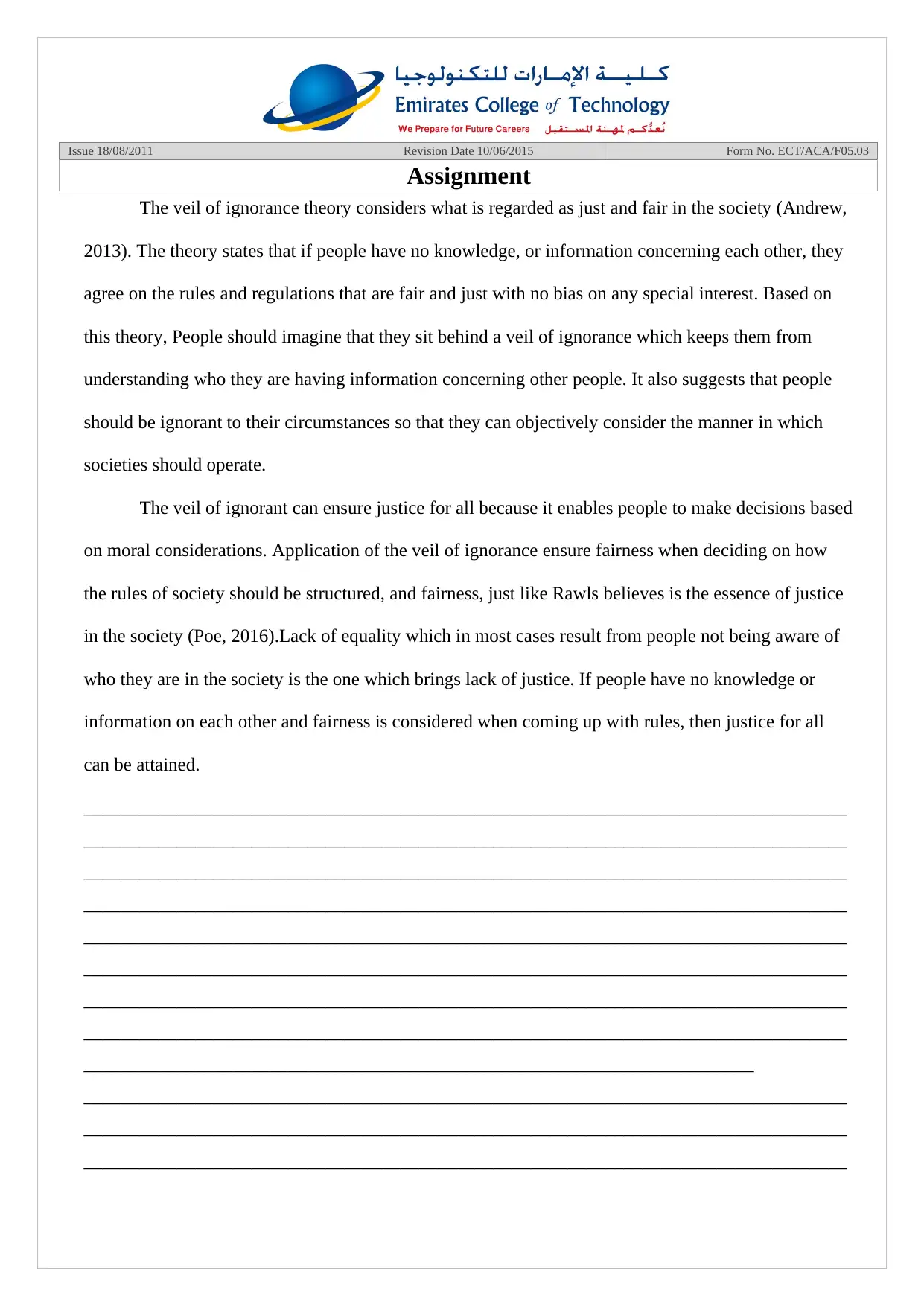
Issue 18/08/2011 Revision Date 10/06/2015 Form No. ECT/ACA/F05.03
Assignment
The veil of ignorance theory considers what is regarded as just and fair in the society (Andrew,
2013). The theory states that if people have no knowledge, or information concerning each other, they
agree on the rules and regulations that are fair and just with no bias on any special interest. Based on
this theory, People should imagine that they sit behind a veil of ignorance which keeps them from
understanding who they are having information concerning other people. It also suggests that people
should be ignorant to their circumstances so that they can objectively consider the manner in which
societies should operate.
The veil of ignorant can ensure justice for all because it enables people to make decisions based
on moral considerations. Application of the veil of ignorance ensure fairness when deciding on how
the rules of society should be structured, and fairness, just like Rawls believes is the essence of justice
in the society (Poe, 2016).Lack of equality which in most cases result from people not being aware of
who they are in the society is the one which brings lack of justice. If people have no knowledge or
information on each other and fairness is considered when coming up with rules, then justice for all
can be attained.
__________________________________________________________________________________
__________________________________________________________________________________
__________________________________________________________________________________
__________________________________________________________________________________
__________________________________________________________________________________
__________________________________________________________________________________
__________________________________________________________________________________
__________________________________________________________________________________
________________________________________________________________________
__________________________________________________________________________________
__________________________________________________________________________________
__________________________________________________________________________________
Assignment
The veil of ignorance theory considers what is regarded as just and fair in the society (Andrew,
2013). The theory states that if people have no knowledge, or information concerning each other, they
agree on the rules and regulations that are fair and just with no bias on any special interest. Based on
this theory, People should imagine that they sit behind a veil of ignorance which keeps them from
understanding who they are having information concerning other people. It also suggests that people
should be ignorant to their circumstances so that they can objectively consider the manner in which
societies should operate.
The veil of ignorant can ensure justice for all because it enables people to make decisions based
on moral considerations. Application of the veil of ignorance ensure fairness when deciding on how
the rules of society should be structured, and fairness, just like Rawls believes is the essence of justice
in the society (Poe, 2016).Lack of equality which in most cases result from people not being aware of
who they are in the society is the one which brings lack of justice. If people have no knowledge or
information on each other and fairness is considered when coming up with rules, then justice for all
can be attained.
__________________________________________________________________________________
__________________________________________________________________________________
__________________________________________________________________________________
__________________________________________________________________________________
__________________________________________________________________________________
__________________________________________________________________________________
__________________________________________________________________________________
__________________________________________________________________________________
________________________________________________________________________
__________________________________________________________________________________
__________________________________________________________________________________
__________________________________________________________________________________
Paraphrase This Document
Need a fresh take? Get an instant paraphrase of this document with our AI Paraphraser
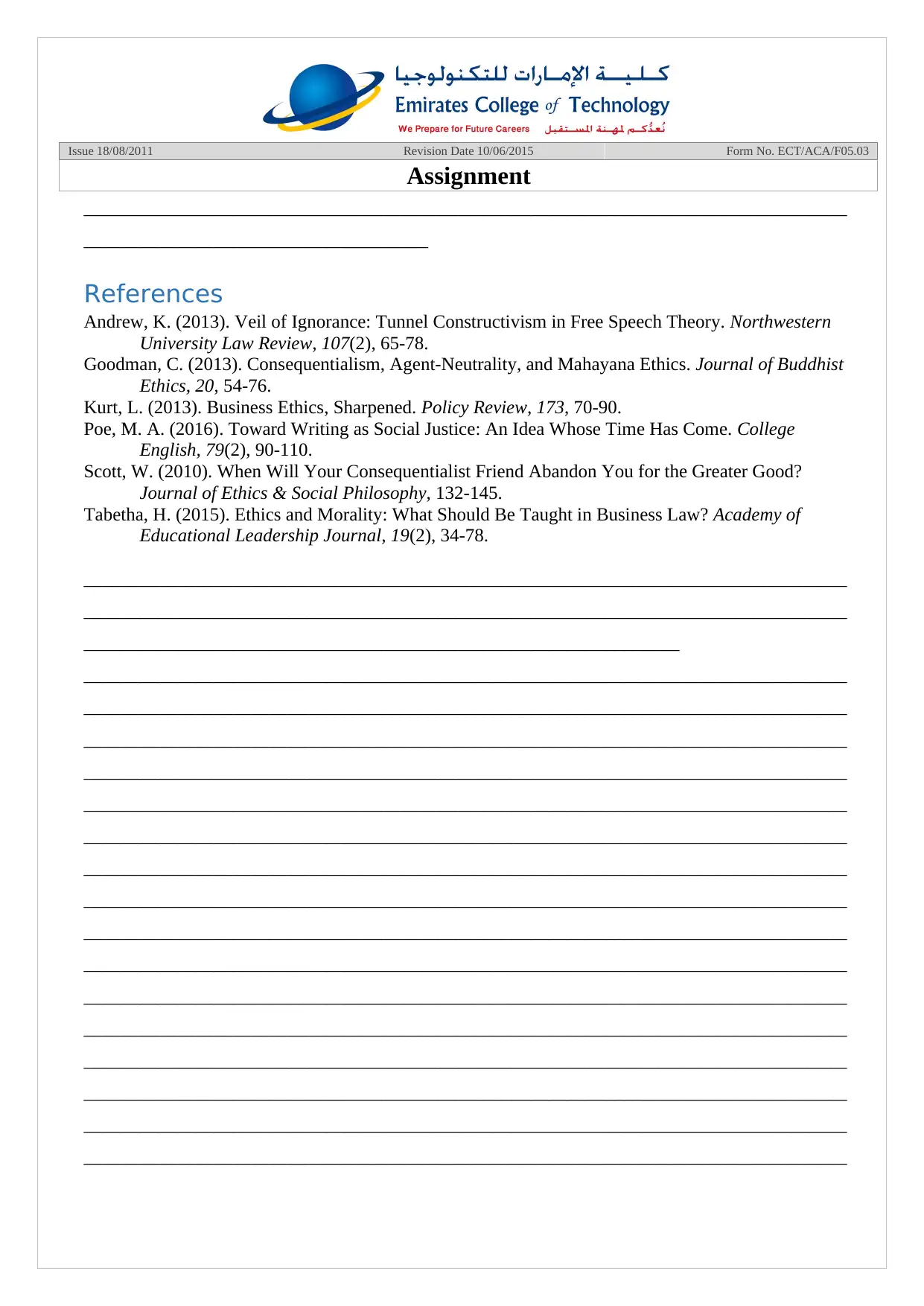
Issue 18/08/2011 Revision Date 10/06/2015 Form No. ECT/ACA/F05.03
Assignment
__________________________________________________________________________________
_____________________________________
References
Andrew, K. (2013). Veil of Ignorance: Tunnel Constructivism in Free Speech Theory. Northwestern
University Law Review, 107(2), 65-78.
Goodman, C. (2013). Consequentialism, Agent-Neutrality, and Mahayana Ethics. Journal of Buddhist
Ethics, 20, 54-76.
Kurt, L. (2013). Business Ethics, Sharpened. Policy Review, 173, 70-90.
Poe, M. A. (2016). Toward Writing as Social Justice: An Idea Whose Time Has Come. College
English, 79(2), 90-110.
Scott, W. (2010). When Will Your Consequentialist Friend Abandon You for the Greater Good?
Journal of Ethics & Social Philosophy, 132-145.
Tabetha, H. (2015). Ethics and Morality: What Should Be Taught in Business Law? Academy of
Educational Leadership Journal, 19(2), 34-78.
__________________________________________________________________________________
__________________________________________________________________________________
________________________________________________________________
__________________________________________________________________________________
__________________________________________________________________________________
__________________________________________________________________________________
__________________________________________________________________________________
__________________________________________________________________________________
__________________________________________________________________________________
__________________________________________________________________________________
__________________________________________________________________________________
__________________________________________________________________________________
__________________________________________________________________________________
__________________________________________________________________________________
__________________________________________________________________________________
__________________________________________________________________________________
__________________________________________________________________________________
__________________________________________________________________________________
__________________________________________________________________________________
Assignment
__________________________________________________________________________________
_____________________________________
References
Andrew, K. (2013). Veil of Ignorance: Tunnel Constructivism in Free Speech Theory. Northwestern
University Law Review, 107(2), 65-78.
Goodman, C. (2013). Consequentialism, Agent-Neutrality, and Mahayana Ethics. Journal of Buddhist
Ethics, 20, 54-76.
Kurt, L. (2013). Business Ethics, Sharpened. Policy Review, 173, 70-90.
Poe, M. A. (2016). Toward Writing as Social Justice: An Idea Whose Time Has Come. College
English, 79(2), 90-110.
Scott, W. (2010). When Will Your Consequentialist Friend Abandon You for the Greater Good?
Journal of Ethics & Social Philosophy, 132-145.
Tabetha, H. (2015). Ethics and Morality: What Should Be Taught in Business Law? Academy of
Educational Leadership Journal, 19(2), 34-78.
__________________________________________________________________________________
__________________________________________________________________________________
________________________________________________________________
__________________________________________________________________________________
__________________________________________________________________________________
__________________________________________________________________________________
__________________________________________________________________________________
__________________________________________________________________________________
__________________________________________________________________________________
__________________________________________________________________________________
__________________________________________________________________________________
__________________________________________________________________________________
__________________________________________________________________________________
__________________________________________________________________________________
__________________________________________________________________________________
__________________________________________________________________________________
__________________________________________________________________________________
__________________________________________________________________________________
__________________________________________________________________________________

Issue 18/08/2011 Revision Date 10/06/2015 Form No. ECT/ACA/F05.03
Assignment
__________________________________________________________________________________
__________________________________________________________________________________
__________________________________________________________________________________
__________________________________________________________________________________
__________________________________________________________________________________
__________________________________________________________________________________
__________________________________________________________________________________
__________________________________________________________________________________
__________________________________________________________________________________
__________________________________________________________________________________
__________________________________________________________________________________
__________________________________________________________________________________
__________________________________________________________________________________
__________________________________________________________________________________
__________________________________________________________________________________
__________________________________________________________________________________
__________________________________________________________________________________
__________________________________________________________________________________
__________________________________________________________________________________
__________________________________________________________________________________
__________________________________________________________________________________
__________________________________________________________________________________
__________________________________________________________________________________
__________________________________________________________________________________
__________________________________________________________________________________
__________________________________________________________________________________
__________________________________________________________________________________
__________________________________________________________________________________
__________________________________________________________________________________
__________________________________________________________________________________
__________________________________________________________________________________
__________________________________________________________________________________
Assignment
__________________________________________________________________________________
__________________________________________________________________________________
__________________________________________________________________________________
__________________________________________________________________________________
__________________________________________________________________________________
__________________________________________________________________________________
__________________________________________________________________________________
__________________________________________________________________________________
__________________________________________________________________________________
__________________________________________________________________________________
__________________________________________________________________________________
__________________________________________________________________________________
__________________________________________________________________________________
__________________________________________________________________________________
__________________________________________________________________________________
__________________________________________________________________________________
__________________________________________________________________________________
__________________________________________________________________________________
__________________________________________________________________________________
__________________________________________________________________________________
__________________________________________________________________________________
__________________________________________________________________________________
__________________________________________________________________________________
__________________________________________________________________________________
__________________________________________________________________________________
__________________________________________________________________________________
__________________________________________________________________________________
__________________________________________________________________________________
__________________________________________________________________________________
__________________________________________________________________________________
__________________________________________________________________________________
__________________________________________________________________________________
⊘ This is a preview!⊘
Do you want full access?
Subscribe today to unlock all pages.

Trusted by 1+ million students worldwide

Issue 18/08/2011 Revision Date 10/06/2015 Form No. ECT/ACA/F05.03
Assignment
__________________________________________________________________________________
__________________________________________________________________________________
__________________________________________________________________________________
__________________________________________________________________________________
__________________________________________________________________________________
__________________________________________________________________________________
__________________________________________________________________________________
__________________________________________________________________________________
__________________________________________________________________________________
__________________________________________________________________________________
__________________________________________________________________________________
__________________________________________________________________________________
__________________________________________________________________________________
__________________________________________________________________________________
__________________________________________________________________________________
__________________________________________________________________________________
__________________________________________________________________________________
__________________________________________________________________________________
__________________________________________________________________________________
Assignment
__________________________________________________________________________________
__________________________________________________________________________________
__________________________________________________________________________________
__________________________________________________________________________________
__________________________________________________________________________________
__________________________________________________________________________________
__________________________________________________________________________________
__________________________________________________________________________________
__________________________________________________________________________________
__________________________________________________________________________________
__________________________________________________________________________________
__________________________________________________________________________________
__________________________________________________________________________________
__________________________________________________________________________________
__________________________________________________________________________________
__________________________________________________________________________________
__________________________________________________________________________________
__________________________________________________________________________________
__________________________________________________________________________________
1 out of 7
Related Documents
Your All-in-One AI-Powered Toolkit for Academic Success.
+13062052269
info@desklib.com
Available 24*7 on WhatsApp / Email
![[object Object]](/_next/static/media/star-bottom.7253800d.svg)
Unlock your academic potential
Copyright © 2020–2025 A2Z Services. All Rights Reserved. Developed and managed by ZUCOL.





